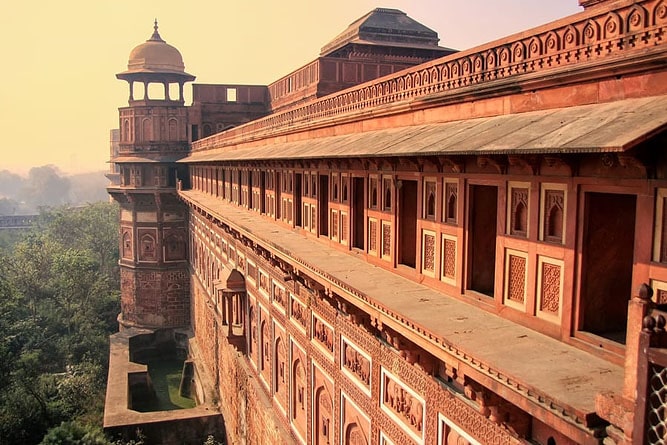Agra Fort
Historical monument in Agra
should-see attraction
Opening hours: dawn-dusk
Address: Rakabganj, Agra
Ticket price: Indian/foreigner ₹50/650, video ₹25
Visit duration: People typically spend 1 to 2 hours here
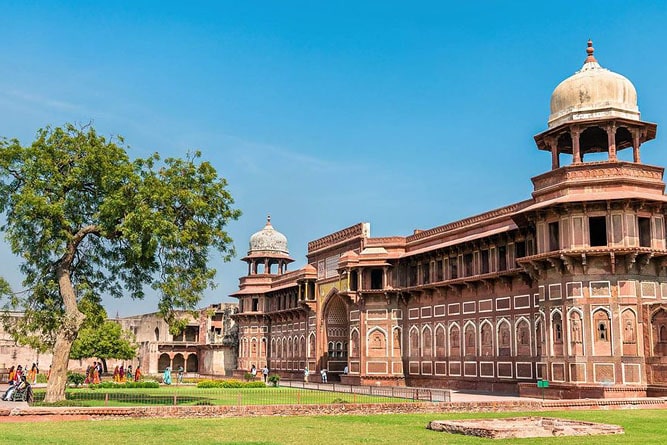
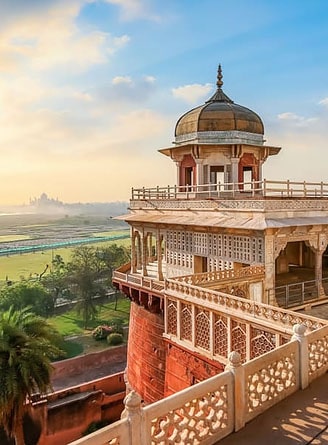
About Agra Fort
During its early days, the Agra fort had been home to the Mughal emperors during their reign in the 15th and 16th centuries. The fort goes by three sobriquets, ‘Fort Rouge’, ‘Lal-Qila’, and ‘Qila-i-Akbari’. It is located a mile and a half northwest of the Taj Mahal.
This citadel in Agra used to be the capital for the Mughal Dynasty before they shifted to Delhi in 1638. Inscribed in the list of World Heritage Sites by UNESCO in 1983, the Agra Fort witnessed the decline of reputed monarchies. It stands as one of the most visited tourist destinations in the city.
History of the Fort
The Agra Fort is a library of historical events narrating the tales of warrior kings. The citadel existed prior to the Mughal rule but its story before the invasion of Mohammad Ghaznavi is not worth mentioning. It was only after the fort was conquered by the founder of Mughal rule in India, Babur, after the Panipat Battle in 1526 that it became a prominent landmark in the region.
Though Babur's son had lost it to the Sultanate ruler he was able to recapture it only to lose it again to a Hindu king Hem Chandra Vikramaditya, also known as Hemu in the Battle of Tughlaqabad. The victory of the king was short-lived as Humayun's son and the mightiest of all Mughal kings, Akbar, clashed with him hastily a month later and emerged victorious and reclaimed the Fort.
Akbar realised the significance of the location and made it the capital of his kingdom. When Akbar arrived in Agra the fort was in ruins. Akbar modified the palace with red sandstones brought in from the Barauli area in Dhaulpur district, Rajasthan. The fort served as Akbar's court.
The fort gained its beauty during the reign of the next ruler, Shah Jahan, who renovated the site by building the Taj Mahal and the Diwan-i-Khas, and two very beautiful mosques. He had also built the Jahangir Palace and the Khas Mahal.
Later Ratan Singh ki Haveli was built by the Jat rulers of Bharatpur during their 13 years of reign. In the earlier 18th century, the Maratha empire invaded and captured the Fort. Since then, the fort had many masters including the Maratha and their foes. They faced their disastrous defeat in the third battle of Panipat against Ahmad Shah Abdali, the founder of the Durrani Empire. A decade later they reclaimed the citadel but ultimately lost the Fort to the British in the second Anglo- Maratha War.
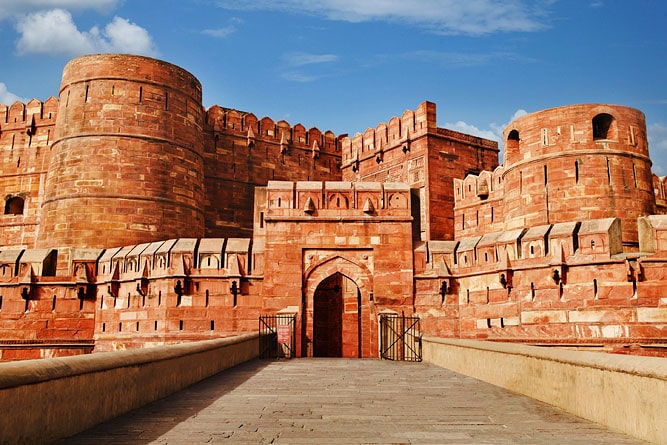
Historical sites inside the Fort
-
Jahangir's Hauz
Carved from a single block of stone, the tank was used for bathing. Despite its popular name, Jahangir Mahal, originally it was part of Akbar's Bengali Mahal. The external part of the rim has a Persian inscription, Hauz-e-Jahangir. The tank travelled from the courtyard of Akbar's palace to Diwan-e-Am, to Company Bagh and back to the Fort. It underwent some damage during its stay in the public garden.
-
Shah Jahani Mahal
Forming a bridge between two eras of the red stone Jahangiri Mahal and the white marble Khas Mahal, the palace has settled down. The monuments depict an early attempt by emperor Shah Jahan to express his passion for white marble-themed architecture.
-
Ghaznin Gate
The original owner of the gate was Mahmud Ghaznavi at Ghazni. It was a part of his tomb. It was brought by the British to India in the mid-19th century. The gate is made of deodar wood from Ghazni and bears an Arabic inscription on its top along with the name of Mahmud accompanied by his epithets carved on it.
-
The Muthamman Burj or the Shah Burj
Also known as the imperial or King's tower, the octagonal palace was used by Akbar, Jahangir and Shah Jahan for jharokha darshan. It surmounts the largest bastion of Agra Fort. This was the official palace for the Mughal Emperors during their dynasty.
-
Shish Mahal
The glass of this summer palace of Shah Jahan was imported from Haleb of Syria. The mosaic work on the walls and ceiling of the glass palace shimmering and gleaming in a thousand different manners even in semi-darkness illustrates the unique architectural style of the era.
-
Jahangir's Chain of Justice
The chain was of pure gold with 60 bells weighing 1 quintal which was tied to a stone post on the bank of the river and extended till the battlements of Shah-Burj. It was a memoir of Jahangi's first order as a king. He wanted the people of his kingdom to be able to reach him if they were deceived by the royal administrators. It depicts that the king saw his people beyond the boundary of caste, creed, and social status.
-
Other attractions are the Anguri Bagh (the garden), Diwan-i-Khas (the hall of private audiences) and the Nagina Masjid (Gem Mosque).
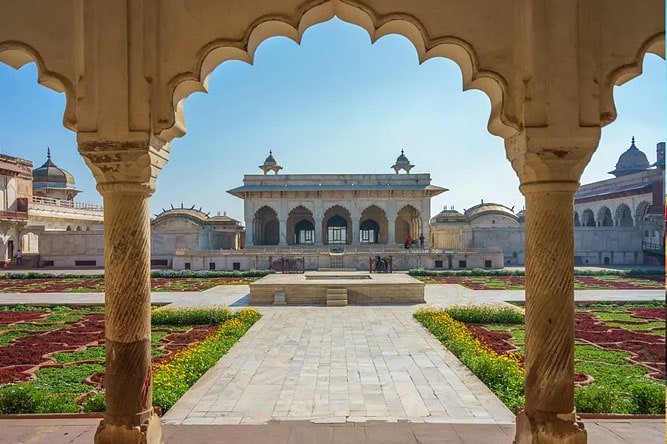
Entry fee and timings
The entry fees for Indians and tourists from SAARC and BIMSTEC are ₹50 and for foreign tourists are ₹650. The fort is open throughout the week from dawn to dusk.
Facts and tips about Agra Fort
- The coronation ceremony of Humanyun, the second Mughal ruler of India, took place in the Agra Fort in 1530.
- The Fort was the prime site of a battle during the Revolt of 1857 which records the end of the rule of the East India Company in India and the beginning of the direct rule of the British Imperial.
- Emperor Akbar was fascinated by the architectural design of the Gwalior Fort and implemented the designs while modifying the Agra Fort.
- There is accessibility for wheelchairs so that old or physically weak people can also enjoy their visit.
- Only 25% of the Fort is allowed for touring, the rest is restricted and used by the Indian Army.
- The Amar Singh Gate is at present the only path for entrance and departure to the Fort.
- Wear comfy shoes as the Fort demands a lot of walking to appreciate its regal existence.
How to reach Agra Fort
Agra Fort is situated along the Yamuna River, halfway between the Taj Mahal and Itimad-ud-Daulah (Baby Taj). Both these monuments can be reached in just 5 minutes by car from Agra Fort.
See location on Google Maps
Other attractions near Agra Fort
- Taj Mahal - 2.6 km
- Itimad-ud-Daulah (Baby Taj) - 2.8 km
- Akbar's Tomb (Sikandra) - 14 km
FAQs about Agra Fort
1. Who built the Agra Fort?
The renovation and expansion of the Agra Fort was commissioned by Mughal emperor Akbar in 1565.
2. What is the difference between Agra Fort and the Red Fort in Delhi?
The structure of the Red Fort and the Agra Fort distinguish each other. The Agra Fort is smaller compared to the Red Fort.
3. Can you carry food inside the Agra Fort?
Food is not allowed inside the Fort. You can carry a water bottle.
4. Are we allowed to take pictures inside the fort?
Yes, photography is allowed inside the fort.
